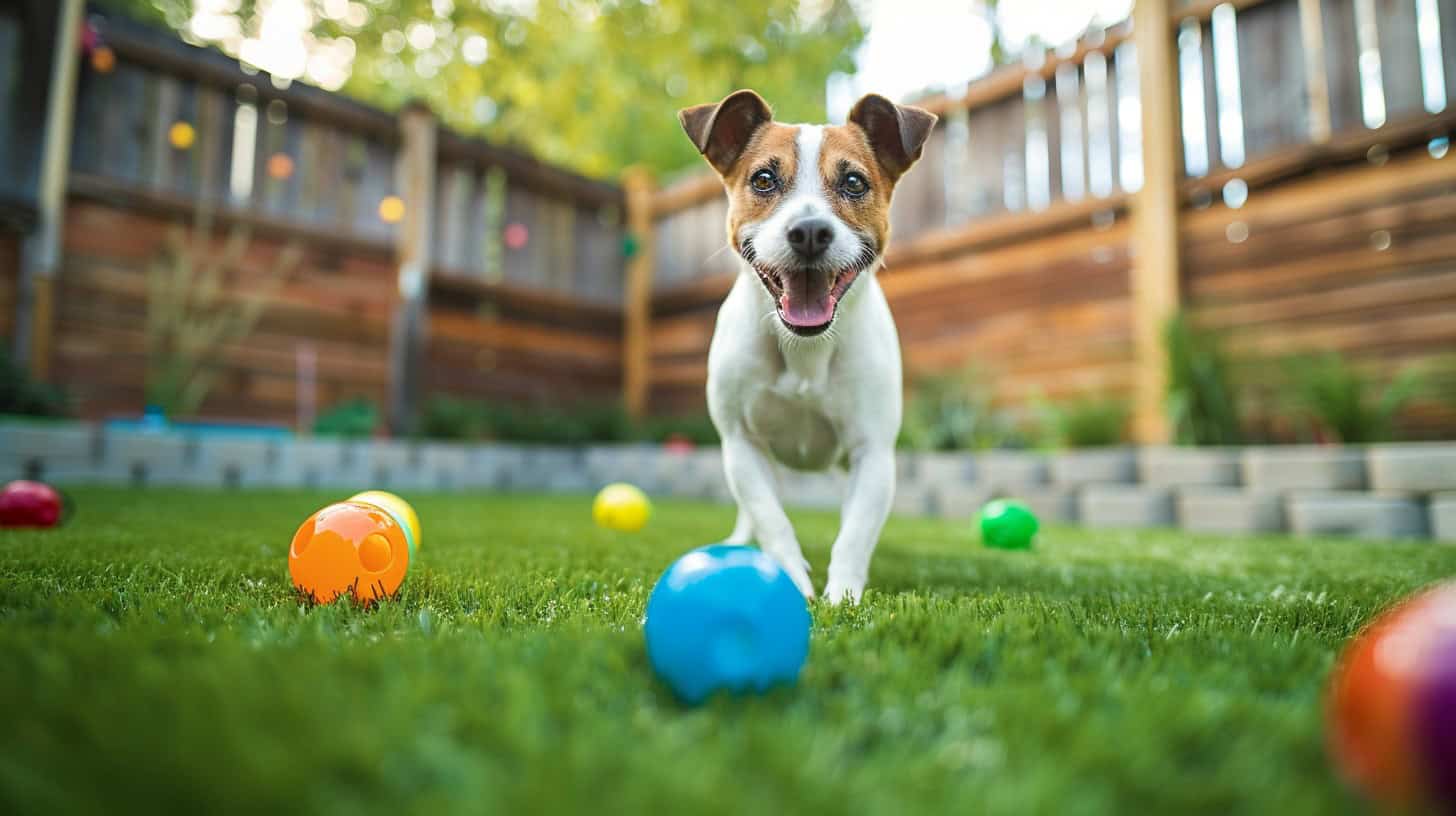Fencing your yard for a dog isn’t just about containment. It’s about creating a safe haven where your furry friend can thrive. Many dog owners underestimate the importance of proper fencing, leading to escape attempts and potential dangers.
A well-designed fence keeps your dog secure and provides peace of mind. The average outdoor fence costs between $1,600 and $7,000 to install, but the investment in your pet’s safety is priceless. 3
This guide will walk you through 6 clever tips for fencing your yard. These strategies work for dogs of all sizes and breeds. Read on to discover how to build a fortress of fun for your four-legged friend. 1
Key Takeaways
Fence height for dogs should be 6-8 feet tall for large breeds, with options like wooden, metal, brick, stone, vinyl, invisible electric, and GPS fences available at costs ranging from $1,600 to $7,000.
Key factors in choosing a fence include the dog’s size, behavior, and energy level, as well as fence visibility, durability, and maintenance requirements.
Solutions for jumpers and climbers include coyote rollers, angled extensions, and smooth materials, while diggers can be deterred with buried chicken wire, rocks, or concrete footers.
Double gates, underground barriers, and fence security alarms connected to smartphones can enhance safety and prevent escapes.
Regular fence maintenance, addressing weak spots promptly, and providing mental and physical stimulation for dogs can help reduce escape attempts and ensure long-term containment.
Table of Contents
Assessing Your Dog’s Fencing Needs
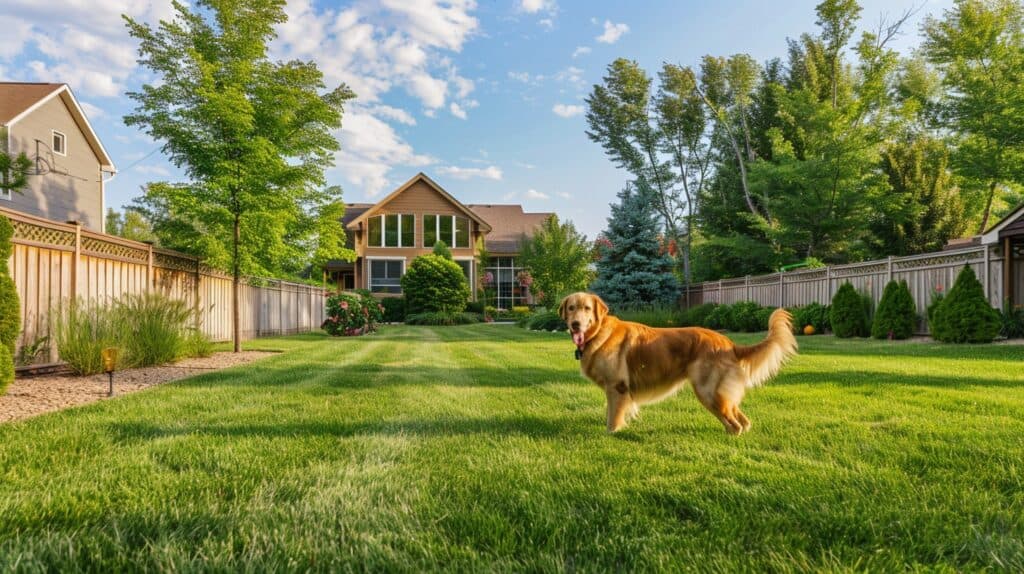
Dog owners must consider breed, size, and behavior when choosing a fence. Active breeds like Border Collies or Australian Shepherds need higher, sturdier barriers. Huskies and German Shepherds require taller fences to prevent jumping. 1 Diggers benefit from underground barriers or concrete footings. A GPS wireless dog fence offers flexibility for large properties. Evaluate your dog’s energy level, escape tendencies, and outdoor space to determine optimal fence height and materials.
Proper fencing prevents escapes, creates safe play areas, and protects gardens. 2 Next, we’ll explore various dog fence options to suit your canine companion’s needs.
Exploring Dog Fence Options
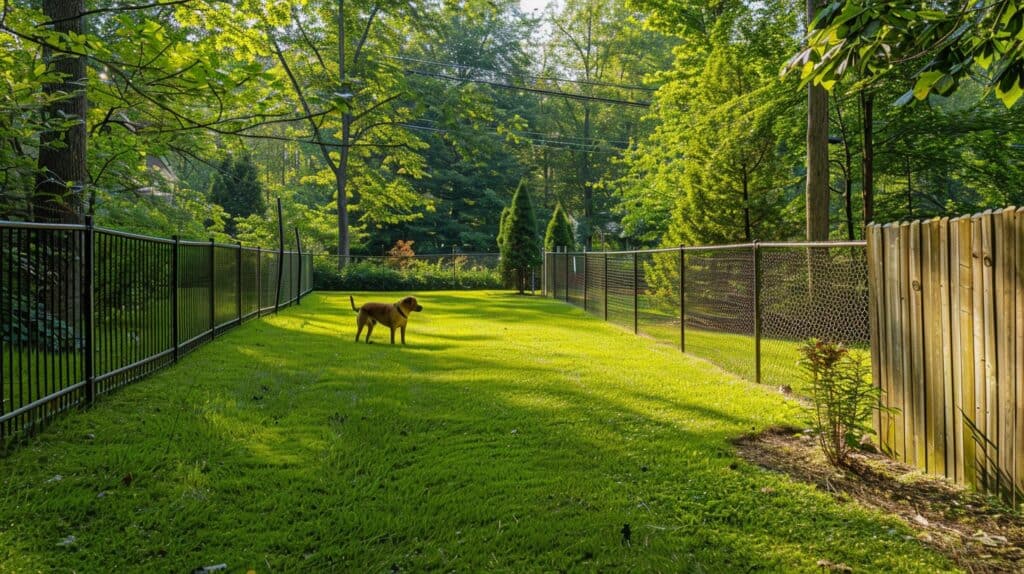
Dog fences come in many shapes and sizes. From classic wooden barriers to high-tech GPS systems, you’ve got options to fit your yard and your pup’s needs.
Wooden Fences
Wooden fences offer a classic, natural look for your yard. They come in various styles – picket, split-rail, and DIY pallet options. These fences provide privacy and can be customized to fit any space.
The initial cost might be higher, but the aesthetic appeal is unmatched.
A good fence makes a good neighbor, but a great fence makes a happy dog. 3
Maintenance is crucial for wooden fences. They’re prone to rot and pest issues. Regular staining or painting keeps them looking fresh and extends their lifespan. For added security, consider adding a coyote roller to prevent jumpers.
Hog wire can reinforce weak spots, ensuring your husky stays put. 1
Metal Fences
Transitioning from wooden options, metal fences offer a robust alternative. Chain link fencing stands out for its affordability and longevity. Ornamental steel or aluminum fences provide a sleek look while preventing fence-running and fence-fighting behaviors in dogs. 1 These barriers require professional installation but deliver long-term value. Metal fences excel in durability and need minimal upkeep, making them a practical choice for busy dog owners.
Caution: Small dogs and puppies might slip through gaps in some metal fence designs. Owners must select appropriate spacing to ensure pet safety. Chain link’s see-through nature can also trigger barking in some dogs. 4 Despite these considerations, metal fences remain a top pick for their strength and reliability in containing canine companions.
Brick Fences
Brick fences offer unparalleled durability and security for your canine companion. These sturdy barriers withstand weather extremes and aggressive dogs, lasting decades with minimal upkeep. 5 Standing 6 to 8 feet tall, they’re ideal for large breeds or escape artists. While pricey upfront, their longevity makes them cost-effective over time.
Brick fences blend aesthetics with functionality. They provide soundproofing, privacy, and a solid barrier against distractions. Installation involves laying a concrete foundation and stacking bricks methodically.
For added strength, reinforce with steel rods. Consider adding decorative elements like capstones or inlaid patterns to enhance curb appeal. 1
Stone Fences
Moving from brick to stone, we find another durable option for dog fencing. Stone fences offer a natural, sustainable solution for canine containment. These barriers, built from local stones or boulders, provide robust physical protection for your furry friend. 7
Stone fences blend seamlessly with natural surroundings, creating an aesthetically pleasing boundary. While the initial cost runs high, their low-maintenance nature and longevity make them a smart investment.
Many homeowners appreciate the rustic charm and solid security these fences bring to their properties. 6
A stone fence isn’t just a barrier; it’s a statement of strength and timelessness in your landscape.
Vinyl Fences
Vinyl fences offer a low-maintenance solution for dog owners. These synthetic barriers resist cracking, rotting, and don’t require painting – a quick hose-down keeps them clean. The average cost in the U.S. hovers around $3,600, making them a mid-range option for homeowners. 8
Durability comes with trade-offs. Extreme weather can damage vinyl, and chewing dogs risk ingesting harmful materials. While eco-conscious buyers might pause at the non-sustainable composition, many appreciate the long-term cost savings and ease of upkeep.
For most canines, vinyl provides a secure, visible boundary that discourages escape attempts. 9
Invisible Electric Fences
Invisible electric fences offer a unique solution for dog containment. These systems use buried wires to create an underground boundary, paired with a collar that emits a warning beep or mild shock when your pup approaches the perimeter.
Setup costs range from $200 to $2,500 in the U.S. 11 The collar activates within a set distance from the wire, discouraging dogs from crossing.
GPS fences provide a humane alternative to shock-based systems. The Tractive GPS Dog Tracker with Virtual Fence allows you to set up to 5 customizable boundaries in under 5 minutes.
It alerts you if your dog escapes, without using electric shocks. This tech combines obedience training and positive reinforcement for effective, pain-free containment. 10
GPS Fences
GPS fences offer a high-tech solution for dog containment. They use satellite technology and a GPS-enabled collar to create virtual boundaries. 12 These systems allow for custom-shaped areas – circular, rectangular, or freeform – to suit your property.
Unlike traditional fences, GPS options provide real-time tracking and activity monitoring. They’re safe, humane, and eliminate the need for physical barriers. 13
Choosing the right GPS fence depends on your property size and coverage needs. Battery life is crucial – longer-lasting models mean fewer interruptions in fence function. Next, let’s explore key considerations for selecting the perfect fence for your furry friend.
Key Considerations for Fence Selection
Picking the right fence for your dog isn’t just about looks. It’s about safety, durability, and your pup’s unique needs – from jumpers to diggers.
Fence Height and Strength
Fence height is crucial for dog containment. Larger breeds need 6 to 8 foot fences. 14 Smaller, calmer dogs might do fine with lower barriers. 15 Escape artists require secure, higher, or privacy fences.
Custom heights and strength match your pup’s size and behavior.
Strong fences resist determined diggers and jumpers. Agile dogs may need coyote rollers or leaning extensions on top. Solid construction prevents gaps or weak spots. Consider your dog’s motivation and compliance when choosing materials.
Next, let’s explore fence visibility and its impact on your yard’s aesthetics.
Fence Visibility
Fence visibility plays a crucial role in dog containment and safety. Solid privacy fences minimize barking by limiting visual distractions. 14 They also deter unwanted intruders, enhancing security for both pet owners and neighbors.
Clear property boundaries, marked by visible fences, help avoid conflicts with adjacent homeowners.
For jumpers and climbers, a tall, opaque barrier proves most effective. Diggers benefit from fences with underground extensions. Border patrollers need sturdy, see-through options like chain-link.
The right visibility choice depends on your dog’s specific behavior. Let’s explore how fence strength impacts canine containment. 3
Fence Durability
Moving from visibility to longevity, durability stands as a crucial factor in fence selection. A sturdy barrier withstands weather, wear, and canine antics. Metal fences offer top-notch durability with minimal upkeep. 16 Vinyl options provide strength and low maintenance but may crack over time. Wooden structures deliver robustness and privacy yet face vulnerability to rot and pests. Regular care extends fence lifespan significantly.
Professional installation ensures optimal performance and longevity for all fence types. 15
Maintenance Requirements
Fence maintenance varies. Metal and vinyl fences need minimal upkeep – just occasional cleaning. Wooden fences demand more attention. They require regular staining or painting to protect against rot and weathering.
Inspect your fence quarterly for loose boards, protruding nails, or signs of pest damage. Fix issues promptly to prevent escape routes. Gates need special care – check hinges and latches monthly, ensuring they close securely.
Proper maintenance extends fence life and keeps your dog safe. 17
Costs differ long-term. Vinyl and metal fences have higher upfront prices but lower maintenance expenses. Wood fences are cheaper initially but rack up ongoing costs for treatments and repairs.
Factor in your time too – DIY maintenance saves money but eats hours. For busy dog owners, low-maintenance options like vinyl prove cost-effective over years. Regular upkeep prevents costly full replacements down the line. 18
Preventing Escape Attempts
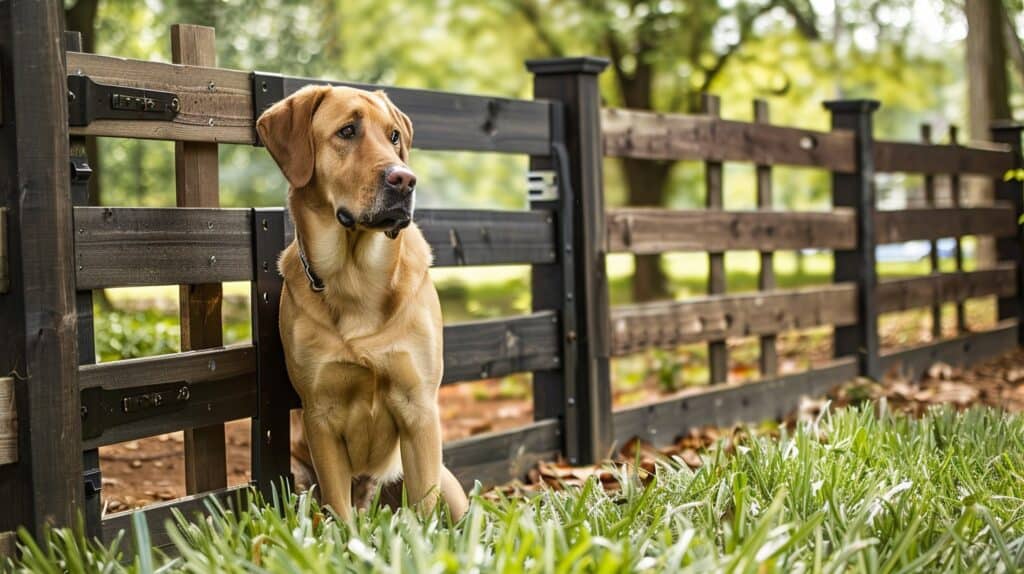
Clever dogs always find ways to escape. But don’t worry – we’ve got solutions for jumpers, climbers, and diggers. Keep reading to learn how to outsmart your furry Houdini….
Solutions for Jumpers and Climbers
High-energy dogs often test fence boundaries. Here are effective solutions to keep jumpers and climbers safely contained:
- Increase fence height to at least 6 feet 19
- Install coyote rollers on top of fences
- Add angled extensions to fence tops, facing inward
- Use smooth materials like vinyl for fencing to prevent grip
- Remove objects near fences that could aid climbing
- Plant dense shrubs along fence lines as natural barriers
- Apply anti-climb spikes or netting to fence tops
- Create visual barriers to reduce outside distractions
- Implement double fencing with a 3-foot gap between 20
- Use electric wire toppers as deterrents (with caution)
Next, we’ll explore solutions for dogs that dig under fences.
Solutions for Diggers
While jumpers and climbers pose their own challenges, diggers require a different approach. Dogs with a penchant for excavation can undermine even the sturdiest fence, but these solutions will keep your canine contained.
- Bury chicken wire at the base of the fence, extending it 1-2 feet into the ground. This creates an underground barrier that frustrates digging attempts. 21
- Place large rocks along the fence line. These natural obstacles deter digging and add visual interest to your yard.
- Lay chain-link fencing flat on the ground, extending 1-2 feet from the fence. This creates an uncomfortable surface for paws, discouraging digging.
- Pour a concrete footer along the perimeter, 6-12 inches deep. This solid barrier stops even the most determined diggers. 22
- Install an L-footer, attaching wire mesh at a 90-degree angle to the bottom of the fence and extending it 1-2 feet outward. This creates a horizontal barrier that dogs can’t dig under.
- Monitor your dog’s behavior and provide plenty of exercise. According to Crystal at Tidbits of Experience, bored dogs often dig, so mental and physical stimulation can curb this tendency.
Solutions for Border Patrollers
Border patrollers are dogs that constantly pace the fence line, seeking escape routes. Here are effective solutions to manage this behavior:
- Install visual barriers: Add privacy slats or screens to chain-link fences to reduce external stimuli.
- Create a designated patrol path: Lay a gravel or mulch path inside the fence perimeter, giving your dog a safe route to satisfy its instinct.
- Use positive reinforcement: Reward your dog for staying away from the fence with treats and praise during training sessions.
- Provide mental stimulation: Set up agility equipment or puzzle toys in the yard to keep your dog engaged and distracted from the fence. 23
- Implement a GPS fence system: Use SpotOn GPS Fence technology for boundary training and tracking your dog’s location via the app.
- Increase exercise: Take your dog on longer walks or runs to burn excess energy that fuels border patrolling behavior.
- Apply deterrent sprays: Use pet-safe, scented sprays along the fence line to discourage your dog from approaching it.
- Install underground barriers: Bury chicken wire or landscape fabric 1-2 feet deep along the fence to prevent digging escape attempts. 22
Enhance Fence Safety Features
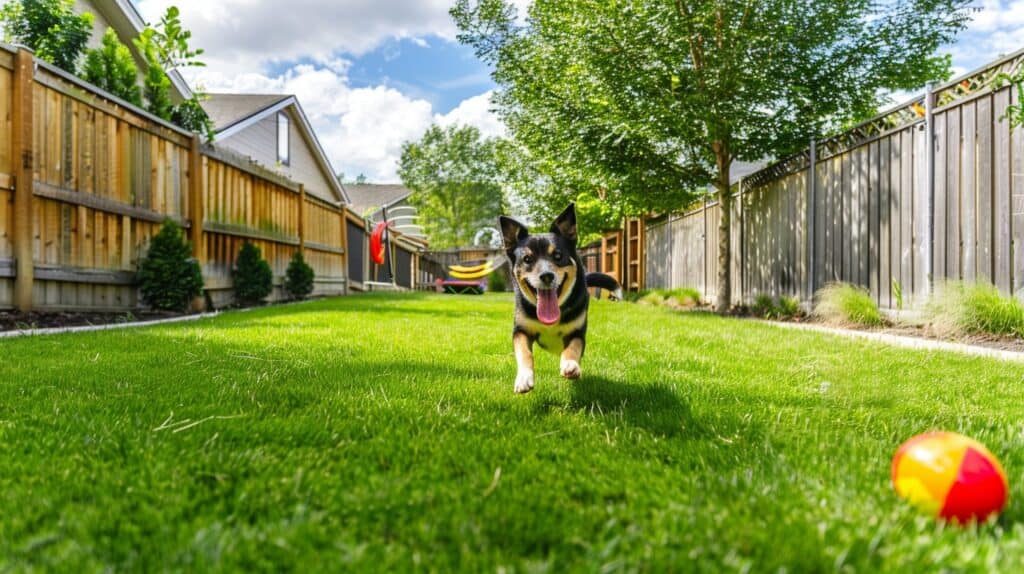
Safety’s key when fencing your yard for a dog. Boost your fence’s effectiveness with these smart add-ons.
Implement Double Gates
Double gates boost yard security and convenience for dog owners. They create a wider entrance, perfect for moving big items like lawnmowers or outdoor furniture. 24 Plus, they add an extra layer of protection – both gates need opening before Fido can bolt.
This setup works great for homes and businesses alike. 24
Installing double gates enhances your fence’s look and function. Make sure to use sturdy latches on both gates to prevent sneaky escapes. 25 The American Kennel Club recommends this feature for improved pet safety.
It’s a smart choice for keeping your furry friend secure while adding curb appeal to your property.
Install Underground Barriers
Underground barriers stop your dog’s escape plans cold. Bury chicken wire or chain-link fencing 1-2 feet deep along the perimeter. This blocks diggers from tunneling out. Pour a concrete footer for extra security.
It’s foolproof against determined pups who love to dig.
Installation takes time, but it’s worth it. You’ll need to dig a trench, lay the fencing, and refill. Plan around yard features like trees or rocks. Once done, train your dog to respect the new boundaries.
This method works great with other fencing to create a secure dog paradise. 2627
Add Fence Security Alarms
Fence security alarms provide a technological enhancement to your dog’s enclosure. These devices promptly notify you if your canine companion attempts to escape. 24 Attach sensors to gates or fence posts – they’ll activate if the barrier’s breached.
Some systems even connect with your smartphone, offering real-time updates on your dog’s location. 28
For increased security, combine alarms with GPS collars. This pairing tracks your dog’s position and notifies you if they move beyond set boundaries. It’s an effective method to monitor adventurous dogs who might test their limits.
Keep in mind that alarms are just one component of a comprehensive fencing strategy. They function optimally alongside sturdy physical barriers and consistent training.
People Also Ask
What’s the best fence for a dog-run?
A split-rail fence works well for a dog run. It’s sturdy, looks nice, and keeps pets safe. You can add wire mesh for extra security.
Are invisible fences good for dogs?
Invisible fences can work, but they’re not for all dogs. They use shock collars, which some find cruel. Traditional fencing is often better for dog behavior and safety.
Can I use pallets to make a dog fence?
Yes, wooden pallets can make a cheap, quick fence. Stack and secure them properly. Add some paint for a nicer look. It’s a creative way to contain your canine.
How do I stop my dog from barking at the fence?
Training is key. Use positive reinforcement. Consider soundproofing materials on the fence. Address any aggression issues. A tired dog is a quiet dog – ensure plenty of exercise.
What’s a good fence material that lasts long?
Polyvinyl chloride (PVC) fencing is durable and low-maintenance. It resists weather and pests. While pricier upfront, it saves money long-term. Plus, it’s safe for pets.
References
^ https://www.whole-dog-journal.com/behavior/leash-barrier-reactivity/solve-fence-aggression-with-a-better-dog-fence/ (2004-03-11)
^ https://mabeltherescuedog.com/2021/11/22/pros-and-cons-of-a-fenced-in-yard-for-dogs/ (2021-11-22)
^ https://bravofencecompany.com/pawsitively-perfect-dog-run-fence-ideas-for-happy-and-safe-pups/ (2024-04-27)
^ https://pethelpful.com/dogs/how-to-build-a-dog-fence (2024-06-30)
^ https://maplewood.worldwebs.com/forums/discussion/best-way-to-fence-in-backyard-for-dog (2018-06-13)
^ https://pennfence.com/create-a-dog-friendly-backyard/
^ https://www.lowes.com/n/how-to/vinyl-fencing-for-dogs
^ https://www.everlastingfence.com/2024/02/15/are-vinyl-fences-a-great-option-for-dogs/ (2024-02-15)
^ https://www.invisiblefence.com/
^ https://robinmacfarlane.com/invisible-fence-for-dogs/
^ https://medium.com/@travisheadd/exploring-the-best-gps-dog-fences-a-comprehensive-guide-1dec9d66a3db
^ https://www.akc.org/expert-advice/home-living/gps-dog-fence/
^ https://skyfenceco.com/how-dog-behavior-influences-your-fence-selection-a-comprehensive-guide/ (2023-07-12)
^ https://artisticfencenj.com/blog/choosing-a-fence-for-your-dog/
^ https://fencebuildersinc.com/choosing-the-right-fence-for-your-dogs-safety/
^ https://keylinkonline.com/blog/how-to-choose-a-fence-for-your-dog-0
^ https://townandcountryfence.net/choosing-the-right-pet-fence-for-your-dogs-yard/ (2023-12-12)
^ https://secure.waysidewaifs.org/site/DocServer/FENCE_CLIMBERS_FENCE_JUMPERS__DIGGERS15.pdf;jsessionid=00000000.app20061a?docID=3485&NONCE_TOKEN=2BEC0B1BFC349150FBAFAB78365DA469
^ https://www.wikihow.com/Keep-a-Dog-from-Jumping-the-Fence
^ https://www.humanesociety.org/resources/how-keep-your-dog-escaping
^ https://www.akc.org/expert-advice/home-living/how-to-keep-a-dog-from-escaping-the-yard/
^ https://spotonfence.com/blogs/training-tips/gps-fence-for-escape-artist-dogs (2022-06-22)
^ https://mulhollandbrand.com/education-center/enhancing-outdoor-security-for-dogs-with-residential-fencing/
^ https://www.instructables.com/Dog-Proof-Chain-Link-Fence-Double-Gate-Latch/
^ https://www.wikihow.com/Install-an-Underground-Dog-Fence
^ https://www.ronhazelton.com/projects/how_to_put_in_an_underground_dog_fence
^ https://skyfenceco.com/how-to-ensure-your-fence-is-pet-friendly-an-installation-guide/
